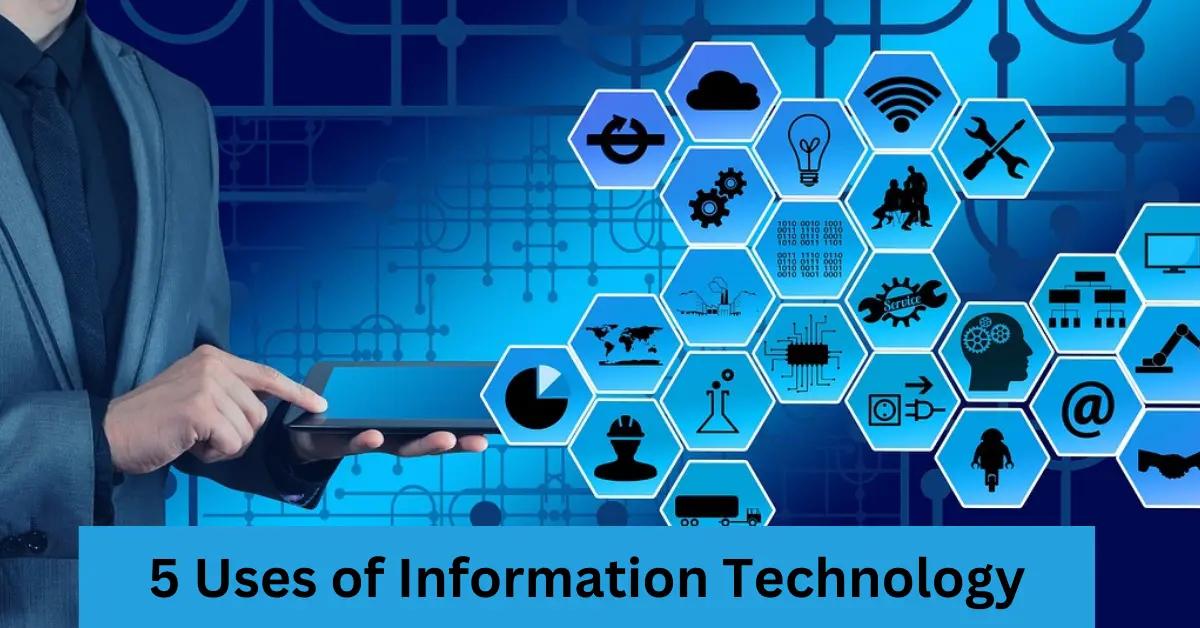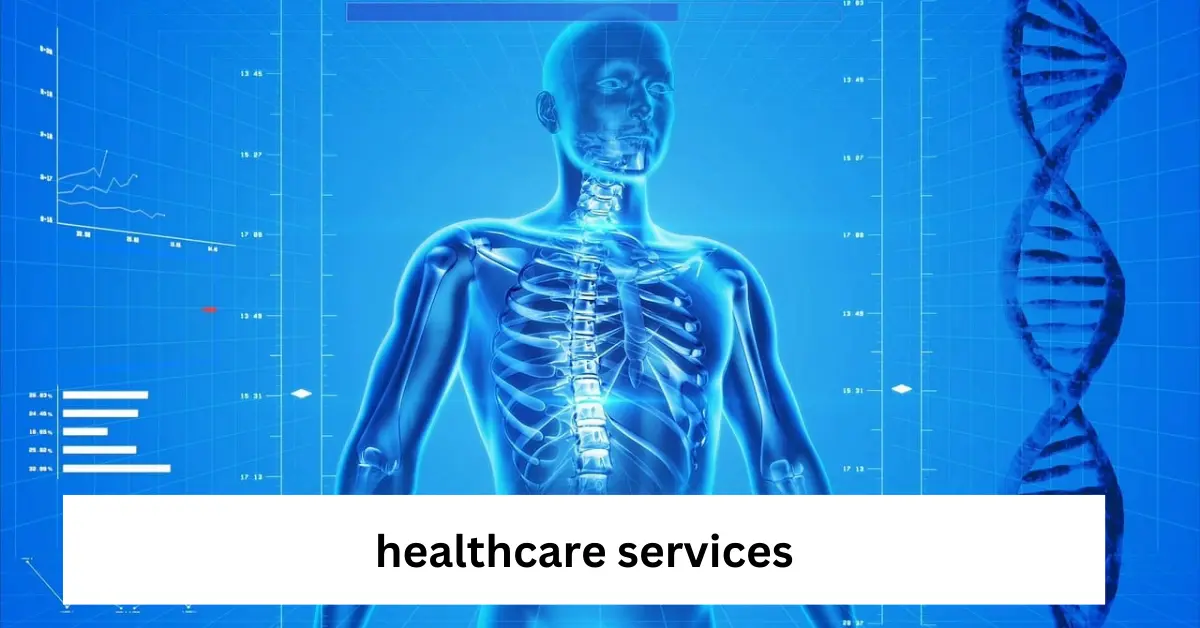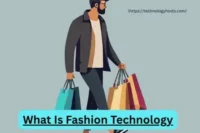Top 5 Uses of Information Technology in Everyday Life
Published: 12 Dec 2024
Information Technology (IT) has become an essential part of our lives, revolutionizing industries, improving daily routines, and shaping the future. From streamlining business operations to enhancing communication, IT empowers individuals and organizations to operate more efficiently and effectively.
In this article, we’ll explore five major uses of information technology that showcase its transformative impact on the modern world. Top 5 Uses of Information Technology

Business Operations
Information technology is the backbone of modern businesses, streamlining processes, improving decision-making, and enabling innovation. IT tools and systems allow companies to operate more efficiently and adapt to rapidly changing market dynamics.what is information technology
Key Applications:
Automation of Routine Tasks: IT systems automate repetitive tasks such as payroll processing, inventory management, and customer relationship management (CRM).
Data Management and Analytics: Businesses use IT to collect, store, and analyze data, providing valuable insights into customer behavior, market trends, and performance metrics.
Enterprise Resource Planning (ERP): ERP systems integrate various business functions, such as finance, supply chain, and human resources, into a unified platform for better coordination and efficiency. 5 uses of information technology on Wikipedia
Real-World Example:
Large corporations like Amazon use IT-driven solutions such as automated warehouses, predictive analytics, and cloud computing to optimize their operations and enhance customer satisfaction.Discover 5G Technology
Impact:
IT enhances productivity, reduces costs, and improves decision-making, giving businesses a competitive edge in the global market.
Online Education: Making Learning Accessible
Information Technology (IT) has transformed the education landscape, making quality learning accessible to people around the world. Online education, powered by IT, offers flexibility, affordability, and inclusivity, breaking barriers of geography, time, and resources. Here’s a detailed look at how IT is shaping the world of online education.
E-Learning Platforms: A Gateway to Knowledge
- E-learning platforms provide a centralized space where learners can access educational content across a wide range of topics. How IT is Revolutionizing Finance
Self-Paced Learning:
Platforms like Khan Academy, Coursera, and Udemy allow learners to progress at their own pace, accommodating their unique schedules and learning styles.
Diverse Course Offerings:
From academic subjects to vocational skills, e-learning platforms cover a broad spectrum of topics, catering to students, professionals, and hobbyists alike.
Certification Programs:
Many platforms offer certificates upon course completion, enhancing career prospects for learners.
Example: Coursera offers certifications from top universities like Stanford and Yale, enabling global learners to access world-class education from the comfort of their homes.
Impact:
E-learning platforms make education more flexible and personalized, allowing learners to achieve their goals at their convenience. Cloud Computing Explained
Healthcare Services: Patient Care

information technology (IT) has transformed the healthcare industry, improving the quality of patient care, streamlining administrative processes, and enabling groundbreaking advancements in medical research. IT empowers healthcare providers to deliver efficient, accessible, and personalized care through tools like electronic health records, telemedicine, and advanced diagnostic technologies.
Here’s a detailed exploration of how IT is revolutionizing patient care:
Electronic Health Records (EHRs):
Electronic Health Records (EHRs) have digitized patient information, making it easier for healthcare providers to access, update, and share patient data in real-time.
Key Benefits:
Centralized Data Storage: EHRs consolidate patient history, test results, prescriptions, and treatment plans in a single digital platform.
- Accessibility: Healthcare professionals can access patient records from anywhere, enabling better coordination of care, especially in emergencies.
- Improved Accuracy: Digitization reduces errors associated with manual record-keeping, such as illegible handwriting or misplaced files.
- Real-World Example:
- Hospitals using EHR systems like Epic and Cerner ensure that patient information is seamlessly shared among specialists, labs, and pharmacies.How to Secure Your IoT Devices
Financial Transactions: Fast and Secure
IT has revolutionized how financial transactions are conducted, making them faster, more secure, and convenient for users. Whether it’s online banking, digital wallets, or blockchain technology, IT has transformed the financial landscape.
Online Banking:
Online banking has become a vital part of everyday financial management, allowing users to perform transactions from the comfort of their homes.
Key Features:
Account Management: Customers can check balances, monitor transactions, and manage multiple accounts from a single dashboard.
- Funds Transfer: IT enables seamless money transfers through platforms like NEFT, RTGS, and UPI, often completing transactions within seconds.
- Bill Payments: Users can schedule and pay utility bills, EMIs, and taxes using online banking portals.
- Real-World Example:
- Banks like Wells Fargo and HSBC offer apps that allow customers to transfer funds, deposit checks, and manage finances remotely. What is IoT (Internet of Things)
Impact:
Online banking reduces the need for physical branch visits, saving time and making financial services more accessible.
Digital Wallets:
Digital wallets have gained immense popularity as a fast and secure way to make payments, both online and offline.
Key Features:
Cashless Transactions: Apps like PayPal, Google Pay, and Apple Pay allow users to pay for goods and services without cash or cards.
Quick Payments: QR codes and near-field communication (NFC) enable instant transactions at retail stores and e-commerce platforms.
Rewards and Cashback: Many wallets offer incentives like cashback, discounts, or loyalty points for frequent users. How IT is Revolutionizing Finance
Real-World Example:
India’s Paytm wallet integrates multiple services, from utility bill payments to movie ticket bookings, making it a one-stop solution for users.
Impact:
Digital wallets provide unparalleled convenience, reducing reliance on cash and promoting the adoption of digital payments.
Global Communication with Information Technology
Information Technology (IT) has revolutionized global communication, making it faster, more accessible, and efficient. From instant messaging and video conferencing to cloud-based collaboration tools and social media, IT enables seamless interaction across borders, fostering connections between individuals, businesses, and organizations worldwide. Tools like WhatsApp, Zoom, and Google Drive facilitate real-time communication and collaboration, while platforms like Facebook and LinkedIn connect communities and professionals globally. IT also bridges language barriers with translation apps like Google Translate, enhances trade and education through e-commerce and virtual classrooms, and promotes economic growth by enabling global partnerships. As IT evolves with trends like 5G and AI, the future promises even more inclusive and immersive global communication.
Information Technology (IT) has transformed the way the world communicates, bridging distances and creating a truly connected global community. With tools like Zoom for video conferencing, WhatsApp for instant messaging, and Google Drive for real-time collaboration, IT enables seamless interaction across continents.
Social media platforms like LinkedIn and Facebook have revolutionized networking, while translation apps like Google Translate overcome language barriers, fostering cross-cultural understanding. IT also powers global commerce through e-commerce platforms and enhances education via virtual classrooms, making knowledge and opportunities accessible to all. As technologies like 5G and AI advance, IT continues to redefine global communication, bringing people and ideas closer together than ever before.
Quiz: Test Your Knowledge on the Uses of Information Technology
a) Online Banking
b) Virtual Classrooms
c) Manual Typewriters
d) Cloud Storage
2. What is the main benefit of using cloud storage?
a) Limited file access
b) Real-time collaboration and remote accessibility
c) Higher costs for small businesses
d) Data stored only on local devices
3. Which IT tool is commonly used for remote healthcare consultations?
a) Zoom
b) Google Maps
c) Spotify
d) Photoshop
4. How does blockchain enhance financial transactions?
a) By decentralizing and securing data in a tamper-proof ledger
b) By speeding up printing processes
c) By replacing the internet for transactions
d) By creating physical copies of digital data
5. Which app is an example of IT’s impact on education?
a) Duolingo
b) Netflix
c) Uber
d) eBay
Answers:
- c) Manual Typewriters
- b) Real-time collaboration and remote accessibility
- a) Zoom
- a) By decentralizing and securing data in a tamper-proof ledger
- a) Duolingo
FAQs
Information technology makes education accessible through online platforms like Coursera and Zoom, enabling students to learn from anywhere in the world. Tools such as virtual classrooms and adaptive learning systems cater to diverse learning styles, breaking geographical and financial barriers.
IT employs encryption protocols like SSL/TLS, multi-factor authentication (MFA), and AI-powered fraud detection systems to secure financial transactions. These technologies ensure that sensitive data remains safe from unauthorized access and cyber threats.
Proudly powered by WordPress






